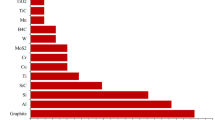Abstract
When the workpiece is sliced by using wire electrical discharge machining (WEDM), the materials are removed by melting and evaporation. Owing to the material removal mechanism, the surface of the workpiece after WEDM is composed of recast layer and numerous discharge craters, leading to the low surface roughness. In this study, wire electrochemical machining (WECM) is introduced to eliminate the recast layer and improve the surface quality of the workpiece cut by using WEDM. Two methods, which are based on electrochemical dissolution reactions, are proposed to dissolve the recast layer and craters on the WEDM surface. The processes are conducted on the same machine tool with the same electrolyte (deionized water) and the same machining parameters. Two factors, which have a great influence on the surface roughness, namely the feed rate of the wire electrode and the movement distance of the workpiece, are analyzed. Experiment results show that the recast layer and craters on the WEDM surface can be dissolved owing to the anodic dissolution of WECM, and the surface quality can be improved. In order to obtain the good surface roughness, the wire electrode should be fed as slow as possible during the electrolysis, and the movement distance of the workpiece should be appropriate.
Similar content being viewed by others
References
Abbas NM, Solomon DG, Bahari MF (2007) A review on current research trends in electrical discharge machining (EDM). Int J Mach Tools Manuf 47(7):1214–1228. https://doi.org/10.1016/j.ijmachtools.2006.08.026
Nguyen MD, Rahman M, Wong YS (2012) Enhanced surface integrity and dimensional accuracy by simultaneous micro-ED/EC milling. CIRP Ann Manuf Technol 61(1):191–194. https://doi.org/10.1016/j.cirp.2012.03.011
Ramasawmy H, Blunt L (2007) Investigation of the effect of electrochemical polishing on EDM surfaces. Int J Adv Manuf Technol 31(11):1135–1147. https://doi.org/10.1007/s00170-005-0302-8
Azam M, Jahanzaib M, Abbasi JA, Abbas M, Wasim A, Hussain S (2016) Parametric analysis of recast layer formation in wire-cut EDM of HSLA steel. Int J Adv Manuf Technol 87(1–4):713–722. https://doi.org/10.1007/s00170-016-8518-3
Ayesta I, Izquierdo B, Flaño O, Sánchez JA, Albizuri J, Avilés R (2016) Influence of the WEDM process on the fatigue behavior of Inconel® 718. Int J Fatigue 92:220–233. https://doi.org/10.1016/j.ijfatigue.2016.07.011
Wu XY, Li SJ (2018) Experimental investigations of a hybrid machining combining wire electrical discharge machining (WEDM) and fixed abrasive wire saw. Int J Adv Manuf Technol 95(5–8):2613–2623. https://doi.org/10.1007/s00170-017-1357-z
Sen M, Shan H (2005) A review of electrochemical macro-to micro-hole drilling processes. Int J Mach Tools Manuf 45(2):137–152. https://doi.org/10.1016/j.ijmachtools.2004.08.005
Zeng Y, Yu Q, Fang X, Xu K, Li H, Qu N (2015) Wire electrochemical machining with monodirectional traveling wire. Int J Adv Manuf Technol 78(5–8):1251–1257. https://doi.org/10.1007/s00170-014-6745-z
Nguyen MD, Rahman M, San Wong Y (2013) Transitions of micro-EDM/SEDCM/micro-ECM milling in low-resistivity deionized water. Int J Mach Tools Manuf 69:48–56. https://doi.org/10.1016/j.ijmachtools.2013.03.008
Nguyen MD, Rahman M, San Wong Y (2012) Simultaneous micro-EDM and micro-ECM in low-resistivity deionized water. Int J Mach Tools Manuf 54:55–65. https://doi.org/10.1016/j.ijmachtools.2011.11.005
Nguyen MD, Rahman M, Wong YS (2012) An experimental study on micro-EDM in low-resistivity deionized water using short voltage pulses. Int J Adv Manuf Technol 58(5–8):533–544. https://doi.org/10.1007/s00170-011-3397-0
Xu ZY, Zhang Y, Ding F, Wang F (2018) An electrochemical discharge drilling method of small deep holes. Int J Adv Manuf Technol 95(5–8):3037–3044. https://doi.org/10.1007/s00170-017-1355-1
Kurita T, Hattori M (2006) A study of EDM and ECM/ECM-lapping complex machining technology. Int J Mach Tool Manu 46(14):1804–1810. https://doi.org/10.1016/j.ijmachtools.2005.11.009
Chung DK, Lee KH, Jeong J, Chu CN (2014) Machining characteristics on electrochemical finish combined with micro EDM using deionized water. Int J Precis Eng Manuf 15(9):1785–1791. https://doi.org/10.1007/s12541-014-0530-7
Hung J-C, Yan B-H, Liu H-S, Chow H-M (2006) Micro-hole machining using micro-EDM combined with electropolishing. J Micromech Microeng 16(8):1480–1486. https://doi.org/10.1088/0960-1317/16/8/007
Zhang Y, Xu Z, Zhu D, Xing J (2015) Tube electrode high-speed electrochemical discharge drilling using low-conductivity salt solution. Int J Mach Tool Manu 92:10–18. https://doi.org/10.1016/j.ijmachtools.2015.02.011
Funding
The work is financially supported by the National Natural Science Foundation of China (No. 51575442).
Author information
Authors and Affiliations
Corresponding author
Rights and permissions
About this article
Cite this article
Wu, X., Li, S., Zhao, W. et al. Experiment investigation of using wire electrochemical machining in deionized water to reduce the wire electrical discharge machining surface roughness. Int J Adv Manuf Technol 102, 343–353 (2019). https://doi.org/10.1007/s00170-018-3196-y
Received:
Accepted:
Published:
Issue Date:
DOI: https://doi.org/10.1007/s00170-018-3196-y




